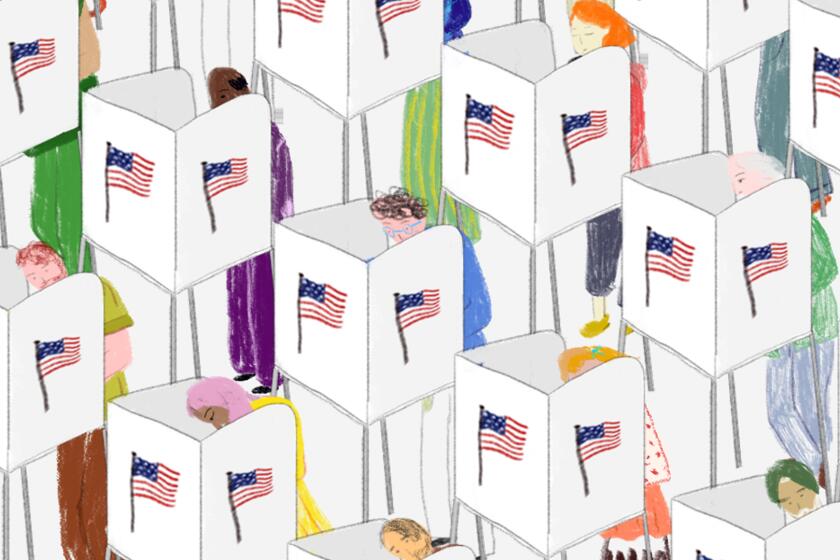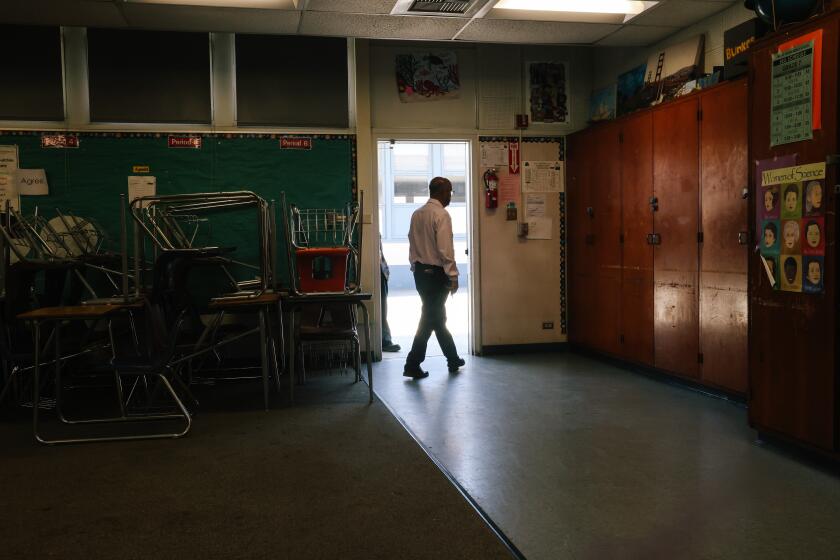Commentary: AI is so rampant now that even a second-grade project is a lesson in deepfakes

My daughter’s second-grade teacher assigned what should have been a straightforward project: an oral presentation about her family’s country of origin with a poster that includes at least five images.
But as my daughter searched online for pictures of the traditions, food and wildlife of Costa Rica, her research ran into an unexpected obstacle.
Her results for three-toed sloths, the slow-moving and beloved tree dwellers that inhabit Costa Rica’s rainforest, turned up a slew of unbearably adorable pictures. Some seemed to smile for the camera as they hung from trees. Closer inspection showed they were too cute to be true. Many of the images that popped up were AI-generated. It turned an assignment about our family’s heritage into a lesson about what’s real on the internet.
From the top of the ticket to local ballot measures, California voters this year are grappling with major decisions that will shape their lives and communities for years to come.
With the increasing amount of generative AI content in search results, social media posts and videos we’re now exposed to online, it’s an issue kids and their parents must be grappling with in nearly every grade now, even more so at higher grade levels. But how much of the online content our kids encounter as they seek to understand the world will be fake?
Since the release of ChatGPT two years ago, Google, Microsoft and other big tech companies have started incorporating AI into search engines, chatbots, mobile devices and a growing number of other features and products.
That’s a huge threat to the business of journalism and other human-generated sources of information that produce the content that companies use to train their generative AI systems, and tech companies have understandably faced backlash from publishers that depend on search traffic. But there’s also the swarm of AI-generated content those searches are linking to, which complicates tasks as simple as looking up real animal pictures.
It didn’t take long for my daughter and her older sister to notice visual clues that could help them determine what images were more likely to be AI-generated. Did the sloth seem to be mugging for the camera? Was its facial expression just a little too human? Those were tip-offs. We laughed as we weeded out the unrealistically vivid and comically fake results, like the sloths in Glamour Shots-style poses.
As an environmental reporter, I write about how climate change is hurting people and the planet. But at home, I’ve struggled to talk about it with my own daughters.
As a millennial, I grew up with the internet, but the digital world of my childhood was slow and unsophisticated, with dial-up modems and competing search engines such as AltaVista and Ask Jeeves. Google Image Search didn’t come out until I was 17 and, being something of a technological skeptic, I got my first cellphone at 21.
My daughters are Generation Alpha, and the digital world they were born into is far more instant, omnipresent and complex. Like many parents, my wife and I have tried to strike a balance between protecting our kids from too much screen time and giving them access to the internet, understanding that much of their lives will be conducted online.
I think my kids’ tech savvy and ability to distinguish between what’s real and what’s AI-generated will be more sophisticated than any prior generation. But it’s sad nonetheless that part of growing up today means learning to navigate an online world so rife with manufactured and misleading content. I worry about the impacts on their conception of truth versus fiction. It seems especially relevant at a time when politicians such as Donald Trump and JD Vance are shamelessly spreading false information, like their dangerous denial of the 2020 election results and racist lies that Haitian immigrants are eating cats.
Voters should approve Proposition 2 to provide $10 billion in bond money for California’s public schools and community colleges, many of which are overdue for repairs and upgrades.
Our children are inheriting an information ecosystem where they must constantly remember not to trust everything they see.
A few days earlier I coincidentally bought my kids a hardbound visual encyclopedia, and they’ve been cracking it open at the dining table to look up things like pandas and dances of the world. As they flipped through its pages, it was reassuring to know I could trust that what they were reading was real and true.
By the time her project was due, my daughter managed to pull together six images of Costa Rica’s flag, food, typical dress and music and found what is hopefully a bonafide sloth hanging from a branch. But I still had to wonder how many of my daughter’s classmates waded through a similar flood of fake images and content as they researched Mexico, the Philippines and other homelands for their presentations.
How many of you have navigated similarly AI-infested waters with your kids? Write to me or to [email protected]. I’d love to hear your experience.
More to Read
A cure for the common opinion
Get thought-provoking perspectives with our weekly newsletter.
You may occasionally receive promotional content from the Los Angeles Times.





![Guitar heatmap AI image. I, _Sandra Glading_, am the copyright owner of the images/video/content that I am providing to you, Los Angeles Times Communications LLC, or I have permission from the copyright owner, _[not copyrighted - it's an AI-generated image]_, of the images/video/content to provide them to you, for publication in distribution platforms and channels affiliated with you. I grant you permission to use any and all images/video/content of __the musician heatmap___ for _Jon Healey_'s article/video/content on __the Yahoo News / McAfee partnership_. Please provide photo credit to __"courtesy of McAfee"___.](https://ca-times.brightspotcdn.com/dims4/default/f4350ab/2147483647/strip/true/crop/1600x1070+0+65/resize/320x214!/quality/75/?url=https%3A%2F%2Fcalifornia-times-brightspot.s3.amazonaws.com%2F60%2Fef%2F08cda72f447d9f64b22a287fa49c%2Fla-me-guitar-heatmap-ai-image.jpg)








